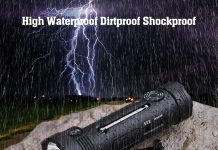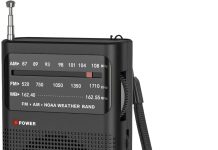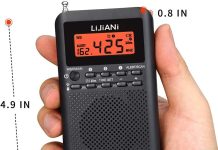Imagine being caught in a severe weather event, with power outages and no access to vital information. That’s where emergency weather radios come to the rescue! But have you ever wondered if these life-saving devices can be powered by batteries? In this article, we explore the possibilities and unravel the truth behind whether emergency weather radios can truly operate on battery power. Get ready to be enlightened and equipped with valuable insights!
Review contents
Overview
Importance of emergency weather radios
When it comes to emergencies, staying informed about the weather conditions is crucial for the safety of individuals and communities. That’s where emergency weather radios come in. These devices are specifically designed to receive broadcasts from weather stations, providing up-to-date alerts, forecasts, and warnings. By having an emergency weather radio on hand, we can have valuable information at our fingertips, enabling us to make informed decisions and take necessary precautions during severe weather events.
Different power options for emergency weather radios
To ensure that we can rely on our emergency weather radios when we need them most, it’s essential to consider the power source. Battery-powered radios are a popular choice due to their versatility and reliability. However, there are different types of batteries to consider, as well as alternative power sources such as solar and hand-crank options. In this article, we will explore the various power options available for emergency weather radios, helping us make an informed decision based on our needs and preferences.
Battery-Powered Emergency Weather Radios
Advantages of battery-powered radios
When it comes to emergency weather radios, the use of batteries brings several advantages. Firstly, battery-powered radios are portable, allowing us to take them anywhere and ensuring we have access to weather information even during power outages or when we’re on the move. Additionally, battery-powered radios eliminate the need for external power sources, making them independent and reliable in emergency situations where electricity may be unavailable.
Types of batteries used in emergency weather radios
There are different types of batteries commonly used in emergency weather radios. These include alkaline batteries, lithium batteries, and zinc-carbon batteries. Each type has its own unique characteristics and performance capabilities. Understanding the differences between these battery options can help us choose the most suitable one for our emergency weather radio.
Standard Disposable Batteries
Alkaline batteries
Alkaline batteries are widely available and come in various sizes, making them a popular choice for emergency weather radios. They are cost-effective and offer good performance over time. One advantage of alkaline batteries is their long shelf life, meaning they can be stored for extended periods without losing their capacity. However, they do have limitations in extreme temperatures and may not provide consistent power output in colder conditions.
Lithium batteries
Lithium batteries are known for their high energy density, providing long-lasting power for emergency weather radios. They are lightweight and perform well in both cold and hot temperatures, making them suitable for a wide range of weather conditions. Another advantage of lithium batteries is their extended shelf life, ensuring they remain functional even during long periods of storage. However, it’s worth noting that lithium batteries can be more expensive compared to other options.
Zinc-carbon batteries
Zinc-carbon batteries are another option for powering emergency weather radios. They are affordable and readily available, making them a convenient choice. However, they generally have a shorter lifespan compared to alkaline or lithium batteries and may not perform well in extreme temperatures. Zinc-carbon batteries can be a suitable option for short-term use or as backup batteries, but they may not be the most reliable choice for long-term emergencies.
Rechargeable Batteries
Nickel-cadmium (NiCd) batteries
Nickel-cadmium batteries have been a popular choice for rechargeable power in various electronic devices, including emergency weather radios. They are known for their long cycle life, meaning they can be recharged and used multiple times before needing to be replaced. However, NiCd batteries are also associated with the “memory effect,” which reduces their overall capacity if not fully discharged before recharging. Additionally, NiCd batteries contain cadmium, a toxic heavy metal, which can have environmental implications if not disposed of properly.
Nickel-metal hydride (NiMH) batteries
Nickel-metal hydride batteries offer an improvement over NiCd batteries, addressing some of the drawbacks associated with their use. They have a higher energy density, providing longer operating time between charges. NiMH batteries do not suffer from the memory effect, allowing them to be recharged at any time without a loss of capacity. They are also more environmentally friendly than NiCd batteries, as they don’t contain toxic metals like cadmium.
Lithium-ion (Li-ion) batteries
Lithium-ion batteries are widely used in many electronic devices due to their high energy density, lightweight design, and long-lasting performance. They are known for their ability to hold a charge for extended periods, making them suitable for emergency weather radios that may be used infrequently. However, it’s important to handle lithium-ion batteries with care, as they can be sensitive to overcharging, overheating, or physical damage. While Li-ion batteries generally have a higher upfront cost, their durability and reliability make them a popular choice for many.
Considerations for Battery-Powered Radios
Battery life and replacement
When selecting batteries for our emergency weather radios, considering battery life is essential. Different battery types have varying capacities, affecting the duration of usage before the need for replacement. Understanding the expected battery life can help us plan for extended emergencies and ensure we have backup batteries readily available if needed. It’s also important to note that rechargeable batteries may have a shorter overall lifespan compared to disposable batteries, requiring replacement after a certain number of charge cycles.
Storage and maintenance of batteries
Proper storage and maintenance of batteries can significantly impact their performance and longevity. To maximize battery life, it’s important to store them in a cool, dry place, away from direct sunlight or extreme temperatures. Regularly inspecting batteries for signs of corrosion or leakage is crucial, as damaged batteries may not function correctly or pose safety risks. It’s also essential to follow manufacturer recommendations for charging and recharging batteries to avoid damaging them and ensure optimal performance.
Environmental impact of different battery types
Considering the environmental impact of our battery choices is another important factor. Batteries contain various metals and chemicals that can be harmful if not disposed of properly. Some battery types, such as zinc-carbon and NiCd batteries, contain toxic substances that should be recycled or disposed of according to local regulations. Opting for rechargeable batteries, such as NiMH or Li-ion, can help reduce waste and minimize our environmental footprint, as they can be reused multiple times before needing replacement.
Alternative Power Sources for Emergency Radios
Solar-powered weather radios
Solar-powered weather radios utilize the energy from the sun to generate power. They typically have built-in solar panels that convert sunlight into electricity, which can be used to charge the radio’s internal battery. Solar-powered radios are an excellent choice for long-term emergencies or situations where access to electricity is limited. They provide a sustainable and renewable power source, ensuring continuous operation as long as sunlight is available. However, solar-powered radios may have limited charging capabilities during overcast or low-light conditions.
Hand-crank emergency radios
Hand-crank emergency radios offer a manual power option, allowing us to generate energy by simply turning a hand crank. This mechanical motion drives an internal generator, which charges the radio’s battery or directly powers the device. Hand-crank radios are ideal for situations where other power sources may not be available, such as during extended power outages or in remote areas. By cranking the handle for a few minutes, we can generate enough power to operate the radio and stay informed.
USB-powered radios
USB-powered radios provide an alternative power source by utilizing USB ports for charging or direct power input. They can be powered by various USB-compatible devices, such as power banks, laptops, or car chargers. USB-powered radios are convenient options for those who may already have USB power sources readily available. However, it’s important to ensure that the USB power source has sufficient capacity to operate the radio for an extended period. Additionally, access to electricity or a charged power bank is necessary to utilize USB-powered radios effectively.
Choosing the Right Battery Option
Factors to consider when selecting batteries
When choosing the right battery option for our emergency weather radio, several factors should be considered. Firstly, we need to evaluate the expected usage and power requirements of the radio. If the radio will be used frequently or for extended periods, it may be more cost-effective to opt for rechargeable batteries. On the other hand, if the radio will be used infrequently or as a backup, disposable batteries may be a suitable choice. Additionally, factors such as battery life, capacity, compatibility, and performance in different weather conditions should also be taken into account.
Application-specific requirements
Different emergency weather radios may have specific battery requirements outlined by the manufacturer. It’s crucial to review the radio’s specifications and guidelines to ensure compatibility with the chosen battery type. Some radios may have voltage or capacity limitations, which can affect the performance and longevity of the batteries. By understanding the application-specific requirements, we can make an informed decision and avoid potential issues or risks associated with using incompatible batteries.
Budget and cost considerations
Budget and cost considerations play a significant role in the selection of batteries for our emergency weather radios. While rechargeable batteries may have a higher upfront cost, they can provide long-term cost savings compared to disposable batteries. Rechargeable batteries also offer the benefit of being reusable, reducing the need for continuous repurchase. However, it’s important to evaluate the overall lifespan and performance of batteries to ensure that the chosen option provides value for money in terms of its durability and reliability.
Tips for Using Battery-Powered Radios
Regularly check and replace batteries
To ensure that our battery-powered emergency weather radios are ready for use when needed, it’s crucial to regularly check the batteries. Inspecting for signs of corrosion, leakage, or diminished capacity can help identify any issues and address them promptly. If the batteries show signs of deterioration or low power output, replacing them with fresh batteries is essential for optimal performance and reliability.
Store backup batteries
Having backup batteries readily available is essential for extended emergencies or situations where power sources may be limited. Storing backup batteries in a cool, dry place and regularly checking their expiration dates can help ensure their effectiveness when needed. It’s also a good practice to rotate stored batteries periodically, using the oldest ones first to prevent them from losing their capacity over time.
Keep the radio in standby mode when not in use
To conserve battery power and prolong their lifespan, it’s advisable to keep the emergency weather radio in standby mode when not in use. Standby mode reduces power consumption while still allowing the radio to receive alerts or broadcasts. By minimizing unnecessary battery drain, we can ensure that the radio is always ready for use when we require instant weather updates or emergency information.
Maximize battery life through power management
Efficient power management techniques can help maximize the battery life of our emergency weather radio. Adjusting the volume level to the minimum necessary, dimming the backlight, and turning off unnecessary features when not needed can significantly extend battery life. Additionally, reducing the radio usage time to essential updates and periodically powering off the device can help conserve power and ensure prolonged battery operation during emergencies.
Maintenance and Troubleshooting
Cleaning and maintenance of battery compartments
Regular cleaning and maintenance of battery compartments are essential for optimal performance and reliability. Accumulated dirt, dust, or debris can hinder battery contact, affecting the power transfer and performance of the radio. It’s recommended to clean the battery compartments periodically using a soft cloth or brush to remove any potential contaminants. Ensuring a clean and secure battery connection can help prevent power interruptions or issues with the radio’s operation.
Addressing common battery-related issues
In some instances, battery-related issues may arise, impacting the operation of our emergency weather radio. These issues can range from batteries not fitting properly or making poor contact to power fluctuations or sudden battery depletion. To address these issues, it’s advisable to check the battery contacts for cleanliness or damage, ensuring a secure fit. If the problems persist, replacing the batteries or seeking professional assistance may be necessary.
Seeking professional assistance if needed
If we encounter persistent battery-related issues or if the emergency weather radio shows signs of malfunction, seeking professional assistance is recommended. Professional technicians or authorized service centers can diagnose and repair any underlying problems, ensuring the radio functions reliably and safely. Attempting to repair or modify the radio ourselves may not only void any existing warranties but also pose potential risks or further damage to the device.
Conclusion
Emergency weather radios are invaluable tools for keeping us informed and safe during severe weather events. By understanding the different power options available, such as battery-powered radios and alternative power sources, we can ensure continuous operation and access to critical weather information. Choosing the right battery option involves considering factors such as battery type, capacity, lifespan, and application requirements. By following essential maintenance tips and troubleshooting techniques, we can maximize the longevity and performance of our battery-powered emergency weather radios. Remember, in times of crisis, having a reliable emergency weather radio can make all the difference in ensuring our safety and well-being.



























